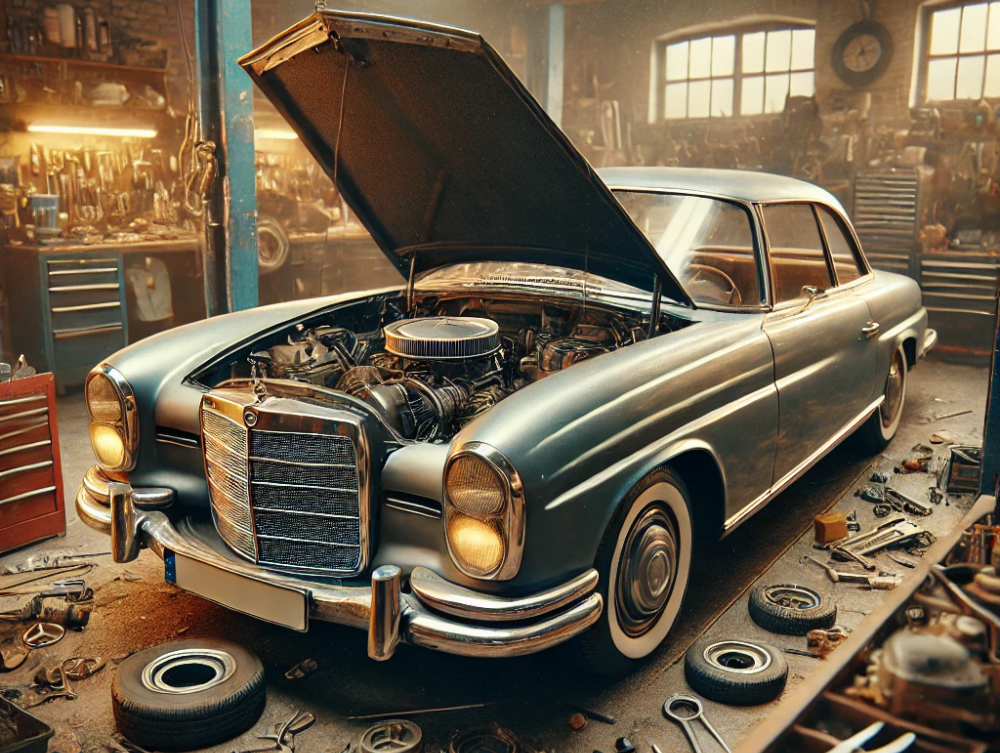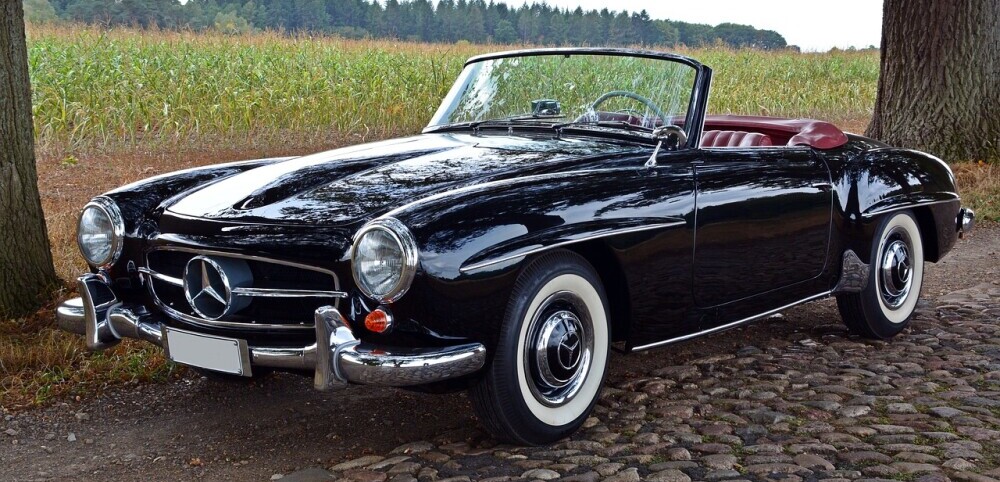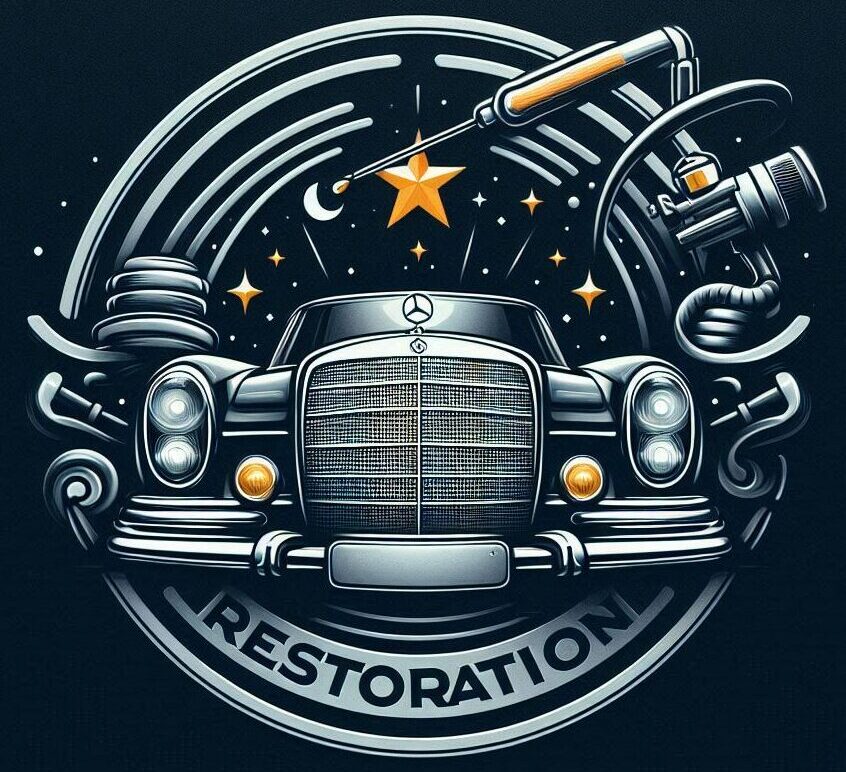
The allure of classic Mercedes cars is something special. These timeless beauties not only represent the pinnacle of automotive design and engineering for their time but also carry the legacy of a brand synonymous with luxury and performance. It’s no wonder enthusiasts, collectors, and casual admirers alike are drawn to bringing these elegant machines back to their former glory. Continue to read the article “Introduction To Classic Mercedes Restoration: Where To Begin” if you plan to restore a Classic Mercedes!
Restoring a classic Mercedes is about enjoying a rewarding journey that combines the excitement of problem-solving with the satisfaction of reviving a piece of history. Imagine cruising in a finely restored 1960s SL Roadster, experiencing the smooth drive that can only come from genuine craftsmanship. That’s the essence of owning a restored classic Mercedes—a blend of history, art, and personal achievement.
Mercedes-Benz has carved out an impressive chapter in automotive history. From their beginnings in the late 19th century, they’ve been leaders in innovation and style. Each classic tells a story of an era defined by luxury, be it the elegance of the 300SL “Gullwing” or the lasting impact of the iconic W123 series. This rich heritage makes restoration not just a hobby but a chance to connect with automotive greatness.
Step-by-Step Guide of Restoring a Classic Mercedes
This step-by-step guide will walk you through the basics of restoring a classic Mercedes, from finding the right model to sourcing parts and budgeting your project. By the end, you’ll have a clear roadmap to begin your restoration journey with confidence.
1. Choosing the Right Model for Your Project
The first step in any restoration project is selecting the model you want to work on. Mercedes has produced a range of classic models, from the timeless 190SL to the elegant W123. Each model has its own unique characteristics, value, and restoration challenges, so it’s essential to choose a model that aligns with your budget, time, and skills.
Considerations When Choosing a Model:
- Personal Preference: Think about what excites you. Do you prefer a convertible like the 190SL, a luxurious sedan like the W108, or a sturdy classic like the W123?
- Parts Availability: Some models, like the W123, have more accessible parts compared to rarer models like the Gullwing. Checking parts availability can save you time and money later on.
- Budget: Restoration costs can vary significantly depending on the model. Generally, more popular models have a larger community and more resources available, which can help reduce costs.
Helpful Resources for Research:
- Classic Mercedes Buyers Guide (Hemmings): Hemmings offers valuable insights into popular Mercedes models, outlining pros, cons, and price ranges. Visit Hemmings Classic Mercedes Guide.
- Mercedes-Benz Club of America (MBCA): The MBCA is a fantastic resource for connecting with other Mercedes enthusiasts. The site has forums, articles, and advice on different models, which can help inform your choice. Visit MBCA.
Once you’ve selected your model, spend time understanding the unique history and technical aspects of that vehicle. This foundation will be invaluable as you begin restoring your classic Mercedes.
2. Evaluating the Condition of Your Classic Mercedes
After choosing your model, the next step is evaluating the car’s current condition. This step will help you understand what needs to be restored or replaced, helping you plan the scope of the project and establish a realistic budget. Here’s how to approach the evaluation:
Key Areas to Check:
- Bodywork: Rust is a common issue in classic cars, particularly along the frame, undercarriage, and wheel wells. Carefully inspect for rust spots and structural damage, as body repairs can be one of the most expensive parts of the restoration.
- Engine and Transmission: Check if the car runs and if the transmission shifts smoothly. If possible, take it to a mechanic who specializes in vintage cars for a pre-purchase inspection.
- Interior Condition: Look at the upholstery, dashboard, and interior trim. Replacing or refurbishing these elements can be costly, so it’s important to assess what can be salvaged and what needs replacement.
- Electrical Systems: Classic Mercedes vehicles often have complex wiring systems that can deteriorate over time. Make sure all lights, indicators, and electronics are functioning, as rewiring can add to the expense.
Where to Get Expert Evaluations:
- Classic Mercedes Forums (Mercedes-Benz Forum): There’s a wealth of knowledge shared by experts on the Mercedes-Benz Forum. This site provides tips on specific areas to inspect based on model and year. Visit Mercedes-Benz Forum.
A thorough inspection will allow you to understand the overall health of your car and help you decide what restoration steps to prioritize.
3. Creating a Restoration Plan and Budget
Once you understand the scope of work, it’s time to create a detailed plan and budget. Having a solid plan in place will keep your project organized and help prevent unexpected expenses.
Steps for Planning Your Restoration:
- Define Your Goals: Are you restoring the car for show, sale, or personal enjoyment? A show car will require a higher level of detail and authenticity, while a personal car can have a bit more flexibility in parts and finishes.
- List the Parts Needed: Create a list of parts that need replacement. Start with essential components like the engine, transmission, and body panels, then add cosmetic items like upholstery and trim.
- Set a Realistic Timeline: Restoration can be a time-consuming process. Set milestones for each stage of the project, such as “engine rebuild,” “bodywork and paint,” and “interior refurbishment.”
- Estimate Costs: Research the cost of parts, labor (if you’re hiring help), and materials. Add a 10-20% buffer to account for unexpected expenses.
Resources for Budgeting and Planning:
- Mercedes-Benz Classic Parts: Mercedes-Benz offers genuine parts specifically for classic models, ensuring that your restoration remains true to the original. Visit Mercedes-Benz Classic Parts.
- Restoration Cost Calculator (Classic Car Restoration Club): This tool helps estimate the cost of a restoration based on your car’s condition and specific needs. Visit Classic Car Restoration Club Cost Calculator.
Setting a budget and having a clear plan will help you stay on track, making the process less overwhelming.

4. Starting the Restoration Process: Step-by-Step Approach
Now that you have your model, a clear understanding of its condition, and a budget in place, it’s time to begin the restoration. Here’s a step-by-step approach to guide you through the actual work:
Steps to Begin Restoration:
- Disassemble Carefully: Start by disassembling your car in stages, labeling and storing each part. For beginners, taking photos during this stage is essential as it helps with reassembly later on.
- Address Rust and Bodywork First: Since rust can worsen over time, prioritize rust treatment and any structural repairs. This is often the most intensive part of the project, especially for older models.
- Rebuild the Engine and Mechanical Parts: Rebuilding the engine, transmission, and other mechanical parts is crucial to get the car running smoothly. If this feels daunting, consider seeking help from a mechanic experienced with classic Mercedes engines.
- Refurbish the Interior: Replace worn seats, repair the dashboard, and update any old trim or upholstery. Pay attention to details, as the interior is what makes the car feel complete.
- Electrical and Final Touches: Once the core mechanical and bodywork are complete, address the electrical system and finish with detailing. Restoring a car is all about the details, so take your time to ensure everything looks polished and functions correctly.
Useful Resources for Restoration:
- Mercedes-Benz Classic Center: Mercedes-Benz offers specialized services for classic car restoration, including engine rebuilds and interior refurbishment. Visit Mercedes-Benz Classic Center.
- DIY Guides (Classic Car Restoration Club): If you’re new to hands-on restoration, Classic Car Restoration Club has tutorials covering various restoration techniques, from rust removal to engine tuning. Visit Classic CarRestoration Club.
Following these steps will create a roadmap for restoring your classic Mercedes, turning an intimidating task into a structured and achievable project.
You can find additional tips for restoring a Mercedes in the following sections:
Assessing Condition: What to Look For in a Restoration Project
Checking out a classic Mercedes isn’t just popping the hood—it’s like putting on your detective hat. Knowing where and what to look for can save you a world of trouble. Start with the engine: hearing a smooth purr when you turn the key is a good sign, but don’t be too quick to trust it. Even quiet engines can hide big issues.
Next, take a look at the car’s body and frame, also known as the chassis. Rust can be the sneaky villain of classic cars, and it often hides in hard-to-see spots. Has the bodywork been patched or repainted? This can signal underlying issues or past accidents that might cost more to fix down the road.
Older Mercedes models have a few common quirks to watch for, too. For instance, head gaskets can start to give out around 100,000 miles, and the car’s vacuum system can be tricky to deal with. Knowing these potential issues early on could save you from major headaches later.
If you’re serious about the car, get a professional who knows classic Mercedes models to take a look. They’ll have the eye for spotting things you might miss and can help you figure out if you’re getting a diamond in the rough or just a money pit.

Finding Parts and Building a Support Network
Restoring a classic car is more than just a one-person job. Connecting with Mercedes restoration clubs or online groups can lead you to valuable advice, expert tips, and hard-to-find parts. These communities are often full of enthusiasts happy to share their knowledge and experiences.
Quality parts are the backbone of any successful restoration. Authentic OEM (Original Equipment Manufacturer) parts are the best fit but can be pricey. Aftermarket parts can be more affordable, but be careful—they don’t always match up in quality. For rare parts, car swap meets and specialist suppliers are great places to look.
Decide if you want to handle the restoration yourself or bring in professionals. Doing it yourself is rewarding but also time-consuming and requires specific skills. Working with experienced professionals could be your best move if it feels overwhelming. Ensure to interview and choose mechanics or craftsmen with a good track record with classic Mercedes models. Don’t be shy—ask for references and check out their past work.
Planning and Budgeting for Your Dream Restoration
Restoring a classic Mercedes requires a solid plan and budget right from the start. While passion fuels the dream, you’ll need a clear game plan to bring that dream to life. Decide early on if you’re aiming for a showroom-worthy look or a car ready for the road. This helps set realistic goals and keeps your project on track.
Breaking the project into smaller tasks—like engine work, body repairs, interior detailing, and finishing touches—will make it more manageable. Setting a timeline for each stage keeps things moving forward and prevents burnout.
Budgeting is critical, and it’s wise to build a cushion into your budget for unexpected costs. From getting the right paint match to tracking down OEM parts, surprises are almost inevitable in restoration work.
Having a clear plan, budget, and timeline makes the journey of restoring a classic Mercedes much smoother. With the right preparation, you’ll spend less time stressing and more time enjoying the process of bringing your dream car to life.

This introduction to classic Mercedes restoration is fantastic! Breaking down the process into four clear steps makes it feel less overwhelming, especially for someone just starting out in the restoration world. I appreciate the advice on planning, budgeting, and finding the right resources—these are crucial elements that can often get overlooked in the excitement of the project. Thanks for making this guide so approachable and practical. I’m feeling inspired to take the first steps toward restoring my dream car!
Thank you so much for the kind words! I’m thrilled to hear that the guide made the restoration process feel more manageable and approachable. Starting a restoration project can feel daunting, but with the right planning and resources, it’s absolutely doable—and incredibly rewarding. I’m excited for you as you take those first steps toward bringing your dream car back to life! Don’t hesitate to reach out if you have any questions along the way. Happy restoring!